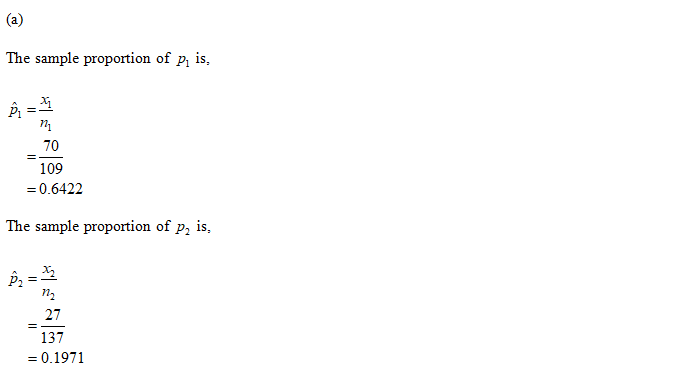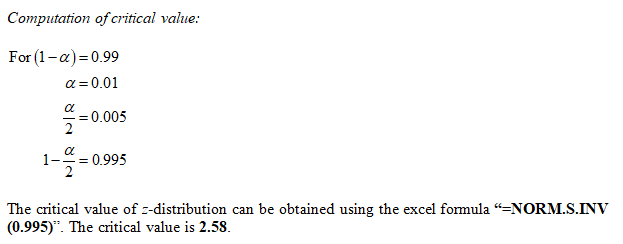"Unknown cultural affiliations and loss of identity at high elevations." These are words used to propose the hypothesis that archaeological sites tend to lose their identity as altitude extremes are reached. This idea is based on the notion that prehistoric people tended not to take trade wares to temporary settings and/or isolated areas. As elevation zones of prehistoric people (in what is now the state of New Mexico) increased, there seemed to be a loss of artifact identification. Consider the following information. Elevation Zone Number of Artifacts Number Unidentified 7000-7500 ft 109 70 5000-5500 ft 137 27 Let p, be the population proportion of unidentified archaeological artifacts at the elevation zone 7000-7500 feet in the given archaeological area. Let p2 be the population proportion of unidentified archaeological artifacts at the elevation zone 5000-5500 feet in the given archaeological area. (a) Find a 99% confidence interval for p, - P2. (Use 3 decimal places.)
"Unknown cultural affiliations and loss of identity at high elevations." These are words used to propose the hypothesis that archaeological sites tend to lose their identity as altitude extremes are reached. This idea is based on the notion that prehistoric people tended not to take trade wares to temporary settings and/or isolated areas. As elevation zones of prehistoric people (in what is now the state of New Mexico) increased, there seemed to be a loss of artifact identification. Consider the following information. Elevation Zone Number of Artifacts Number Unidentified 7000-7500 ft 109 70 5000-5500 ft 137 27 Let p, be the population proportion of unidentified archaeological artifacts at the elevation zone 7000-7500 feet in the given archaeological area. Let p2 be the population proportion of unidentified archaeological artifacts at the elevation zone 5000-5500 feet in the given archaeological area. (a) Find a 99% confidence interval for p, - P2. (Use 3 decimal places.)
MATLAB: An Introduction with Applications
6th Edition
ISBN:9781119256830
Author:Amos Gilat
Publisher:Amos Gilat
Chapter1: Starting With Matlab
Section: Chapter Questions
Problem 1P
Related questions
Concept explainers
Equations and Inequations
Equations and inequalities describe the relationship between two mathematical expressions.
Linear Functions
A linear function can just be a constant, or it can be the constant multiplied with the variable like x or y. If the variables are of the form, x2, x1/2 or y2 it is not linear. The exponent over the variables should always be 1.
Question
How would u solve this

Transcribed Image Text:"Unknown cultural affiliations and loss of identity at high elevations." These are words used to propose the hypothesis that archaeological sites tend to
lose their identity as altitude extremes are reached. This idea is based on the notion that prehistoric people tended not to take trade wares to temporary
settings and/or isolated areas. As elevation zones of prehistoric people (in what is now the state of New Mexico) increased, there seemed to be a loss of
artifact identification. Consider the following information.
Elevation Zone
Number of Artifacts
Number Unidentified
7000-7500 ft
109
70
5000-5500 ft
137
27
Let p, be the population proportion of unidentified archaeological artifacts at the elevation zone 7000-7500 feet in the given archaeological area. Let p2
be the population proportion of unidentified archaeological artifacts at the elevation zone 5000-5500 feet in the given archaeological area.
(a) Find a 99% confidence interval for p, - p2. (Use 3 decimal places.)
lower limit
upper limit
Expert Solution
Step 1


Trending now
This is a popular solution!
Step by step
Solved in 2 steps with 3 images

Knowledge Booster
Learn more about
Need a deep-dive on the concept behind this application? Look no further. Learn more about this topic, statistics and related others by exploring similar questions and additional content below.Recommended textbooks for you

MATLAB: An Introduction with Applications
Statistics
ISBN:
9781119256830
Author:
Amos Gilat
Publisher:
John Wiley & Sons Inc

Probability and Statistics for Engineering and th…
Statistics
ISBN:
9781305251809
Author:
Jay L. Devore
Publisher:
Cengage Learning

Statistics for The Behavioral Sciences (MindTap C…
Statistics
ISBN:
9781305504912
Author:
Frederick J Gravetter, Larry B. Wallnau
Publisher:
Cengage Learning

MATLAB: An Introduction with Applications
Statistics
ISBN:
9781119256830
Author:
Amos Gilat
Publisher:
John Wiley & Sons Inc

Probability and Statistics for Engineering and th…
Statistics
ISBN:
9781305251809
Author:
Jay L. Devore
Publisher:
Cengage Learning

Statistics for The Behavioral Sciences (MindTap C…
Statistics
ISBN:
9781305504912
Author:
Frederick J Gravetter, Larry B. Wallnau
Publisher:
Cengage Learning

Elementary Statistics: Picturing the World (7th E…
Statistics
ISBN:
9780134683416
Author:
Ron Larson, Betsy Farber
Publisher:
PEARSON

The Basic Practice of Statistics
Statistics
ISBN:
9781319042578
Author:
David S. Moore, William I. Notz, Michael A. Fligner
Publisher:
W. H. Freeman

Introduction to the Practice of Statistics
Statistics
ISBN:
9781319013387
Author:
David S. Moore, George P. McCabe, Bruce A. Craig
Publisher:
W. H. Freeman